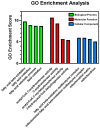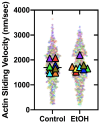Early-Stage Alcoholic Cardiomyopathy Highlighted by Metabolic Remodeling, Oxidative Stress, and Cardiac Myosin Dysfunction in Male Rats
- PMID: 40725013
- PMCID: PMC12296025
- DOI: 10.3390/ijms26146766
Early-Stage Alcoholic Cardiomyopathy Highlighted by Metabolic Remodeling, Oxidative Stress, and Cardiac Myosin Dysfunction in Male Rats
Abstract
Chronic ethanol use can lead to alcoholic cardiomyopathy (ACM), while the impact on the molecular and cellular aspects of the myocardium is unclear. Accordingly, male Sprague-Dawley rats were exposed to an ethanol-containing diet for 16 weeks and compared with a control group that was fed an isocaloric diet. Histological measurements from H&E slides revealed no significant differences in cell size. A proteomic approach revealed that alcohol exposure leads to enhanced mitochondrial lipid metabolism, and electron microscopy revealed impairments in mitochondrial morphology/density. Cardiac myosin purified from the hearts of ethanol-exposed animals demonstrated a 15% reduction in high-salt ATPase activity, with no significant changes in the in vitro motility and low-salt ATPase or formation of the super-relaxed (SRX) state. A protein carbonyl assay indicated a 20% increase in carbonyl incorporation, suggesting that alcohol may impact cardiac myosin through oxidative stress mechanisms. In vitro oxidation of healthy cardiac myosin revealed a dramatic decline in ATPase activity and in vitro motility, demonstrating a link between myosin protein oxidation and myosin mechanochemistry. Collectively, this study suggests alcohol-induced metabolic remodeling may be the initial insult that eventually leads to defects in the contractile machinery in the myocardium of ACM hearts.
Keywords: actin; alcohol; heart failure; mitochondria; muscle contraction; myosin.
Conflict of interest statement
The authors declare no conflicts of interest.
Figures







Similar articles
-
Cardiac myosin motor deficits are associated with left ventricular dysfunction in human ischemic heart failure.Am J Physiol Heart Circ Physiol. 2023 Feb 1;324(2):H198-H209. doi: 10.1152/ajpheart.00272.2022. Epub 2022 Dec 16. Am J Physiol Heart Circ Physiol. 2023. PMID: 36525480 Free PMC article.
-
Antioxidants for male subfertility.Cochrane Database Syst Rev. 2014;(12):CD007411. doi: 10.1002/14651858.CD007411.pub3. Epub 2014 Dec 15. Cochrane Database Syst Rev. 2014. Update in: Cochrane Database Syst Rev. 2019 Mar 14;3:CD007411. doi: 10.1002/14651858.CD007411.pub4. PMID: 25504418 Updated.
-
A myosin hypertrophic cardiomyopathy mutation disrupts the super-relaxed state and boosts contractility by enhanced actin attachment.bioRxiv [Preprint]. 2025 Jul 22:2025.06.02.657466. doi: 10.1101/2025.06.02.657466. bioRxiv. 2025. PMID: 40501550 Free PMC article. Preprint.
-
Astaxanthin Prevented Acute Alcoholic Cardiomyopathy by Maintenance of Mitophagy-Mediated Mitochondrial Homeostasis.J Cell Mol Med. 2025 Jul;29(13):e70714. doi: 10.1111/jcmm.70714. J Cell Mol Med. 2025. PMID: 40653614 Free PMC article.
-
NTP Developmental and Reproductive Toxicity Technical Report on the Prenatal Development Studies of 2-((1-(4-Phenoxyphenoxy)propan-2-yl)oxy)pyridine (CASRN 95737-68-1) in Sprague Dawley (Hsd:Sprague Dawley® SD®) Rats and New Zealand White (Hra:NZW SPF) Rabbits: DART Report 07 [Internet].Research Triangle Park (NC): National Toxicology Program; 2022 Jan. Research Triangle Park (NC): National Toxicology Program; 2022 Jan. PMID: 35593777 Free Books & Documents. Review.
References
MeSH terms
Substances
Grants and funding
LinkOut - more resources
Full Text Sources

